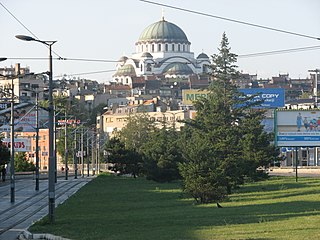 W
WVračar is a municipality of the city of Belgrade. According to the 2011 census results, the municipality has a population of 56,333 inhabitants.
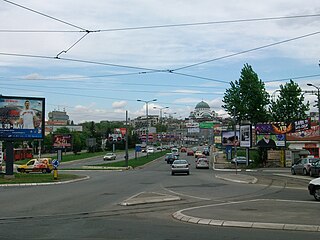 W
WAutokomanda is an urban neighborhood of Belgrade, the capital of Serbia. It is located on the tripoint of the Belgrade's municipalities of Voždovac, Savski Venac and Vračar.
 W
WThe Belgrade Drama Theatre is a theatre located in Belgrade, the capital of Serbia.
 W
WBeograđanka, officially Belgrade Palace is a modern high-rise building in the Belgrade downtown area.
 W
WBulevar kralja Aleksandra is the longest street entirely within the urban limits of Serbian capital Belgrade, with length of 7.5 kilometers. Known for decades after World War II as Bulevar Revolucije, it is so distinct in the Belgraders' hearts and minds that they simply refer to it as the Bulevar, although there are 20 boulevards in Belgrade.
 W
WWhen the Serbs in Banat rose up against the Ottomans in 1594, using the portrait of Saint Sava on their war flags, the Ottomans retaliated by incinerating the relics of St. Sava on the Vračar plateau in Belgrade. Grand Vizier Koca Sinan Pasha, the main commander of the Ottoman army, ordered for the relics to be brought from Mileševa to Belgrade, where he set them on fire on 27 April. Monk Nićifor of the Fenek monastery wrote that "there was great violence carried out against the clergy and devastation of monasteries". The Ottomans sought to symbolically and really, set fire to the Serb determination of freedom, which had become growingly noticeable. The event, however, sparked an increase in rebel activity, until the suppression of the uprising in 1595. It is believed that his left hand was saved; it is currently held at Mileševa.
 W
WThe Co-cathedral of Christ the King is a Catholic place of worship located in Krunska 23, in the city center of Belgrade, Serbia. It is the oldest extant Catholic church in the city south of the Sava and the Danube rivers, and was built between 1924 and 1988, the cathedral of the Archdiocese of Belgrade.
 W
WThe Temple of Saint Sava is a Serbian Orthodox church which sits on the Vračar plateau in Belgrade, Serbia. It was planned as the bishopric seat and main cathedral of the Serbian Orthodox Church. The church is dedicated to Saint Sava, the founder of the Serbian Orthodox Church and an important figure in medieval Serbia. It is built on the presumed location of St. Sava's grave. His coffin had been moved from Mileševa Monastery to Belgrade. It was placed on a pyre and burnt in 1595 by Ottoman Grand Vizier Sinan Pasha. Bogdan Nestorović and Aleksandar Deroko were finally chosen to be the architects in 1932 after a second revised competition in 1926/27. This sudden decision instigated an important debate in interwar Yugoslavia which centred around the temple's size, design and symbolic national function. This was accompanied by a sizeable increase in the base area of the ambitiously conceived project. The new design departed from the competition guidelines issued in 1926, and was to replicate the dimensions and architecture of Hagia Sophia.
 W
WCrveni Krst or colloquially just Krst, is an urban neighborhood of Belgrade, the capital of Serbia. It is located in Belgrade's municipalities of Vračar and Zvezdara.
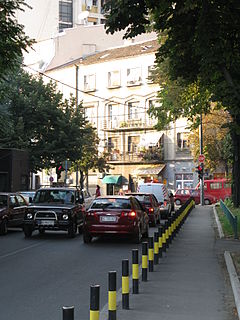 W
WČubura, Serbo-Croatian pronunciation: [t͡ʃǔbura]) is an urban neighborhood of Belgrade, the capital of Serbia. Located in Belgrade's municipality of Vračar, it is a synonym of the city's bohemian life.
 W
WCvetni trg or Flower Square is an urban neighborhood of Belgrade, the capital of Serbia. It is located in the Belgrade municipality of Vračar.
 W
WThe Sculptor Đorđe Jovanović's House is at 6 Skerlićeva Street, Belgrade, and has the status of a cultural monument.
 W
WEnglezovac is an urban neighborhood of Belgrade, the capital of Serbia. It is located in the Belgrade's municipality of Vračar.
 W
WGenčić's family house in Belgrade is situated at 51 Krunska Street and represents the immovable cultural property as the cultural monument.
 W
WGradić Pejton is an urban neighborhood of Belgrade, the capital of Serbia. Located in Belgrade's municipality of Vračar, it is a unique craftmen settlement in the city.
 W
WInstitute of Political Studies in Belgrade is an academic institution in Belgrade, Serbia. It is for research of political science.
 W
WKalenić is an urban neighborhood of Belgrade, the capital of Serbia. It is located in Belgrade's municipality of Vračar, centered on the Kalenić market, one of the main open greenmarkets in Belgrade.
 W
WKarađorđe's Park is a public park and an urban neighborhood of Belgrade, the capital of Serbia. While the park itself is located in Belgrade's municipality of Vračar, majority of what is today considered the neighborhood of Karađorđev Park is since 1957 located in the municipality of Savski Venac.
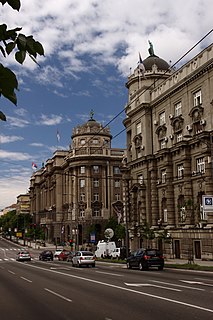 W
WKneza Miloša Street is a street in downtown Belgrade, the capital of Serbia. It was the main city's korzo (promenade) and today is one of the major traffic arteries of the city, location of some of the most important national institutions and a street with the largest number of embassies in Belgrade. It stretches through the territory of three municipalities: Stari Grad, Vračar and Savski Venac. Previously known as Topčider Road, it was later named after prince Miloš Obrenović, the first ruler of modern Serbia.
 W
WThe Krstic Brothers' House is located in Belgrade, at the King Milutin street no.5, since 1973, with the status of cultural heritage. The house was built in the late 19th century as a representative of a residential buildings. As there was no saved data of the architect, it was assumed, based on some elements of decoration, that the author of the project could be the architect Јован Илкић. Soon after the raising of the house, Krstic family moved in. The family were known for their two children, a renowned architects Peter and Branko.
 W
WKrunski Venac is an urban neighborhood of Belgrade, the capital of Serbia. It is located in Belgrade's municipality of Vračar.
 W
WObilić Stadium is a multi-purpose stadium in Belgrade, Serbia. Located in Vračar municipality, it is currently used mostly for football matches. The stadium has a seating capacity for 4,600 people. The venue was the home ground of Obilić. The stadium take their name from Miloš Obilić, a legendary 14th-century knight much celebrated in Serbian epic poetry.
 W
WNatural History Museum is a museum located in Belgrade, Serbia. It is one of the oldest specialized national institutions in Serbia. In fact, it is the only museum of this type in Serbia.
 W
WThe Museum of Paja Jovanović is a memorial museum located in Belgrade, the capital of Serbia. The museum contains the paintings and personal object of one of the most famous Serbian painters, Paja Jovanović.
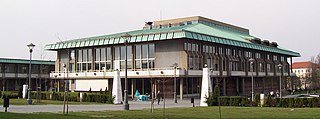 W
WThe National Library of Serbia is the national library of Serbia, located in the capital city of Belgrade. It is the biggest library, and oldest institution in Serbia.
 W
WNeimar is an urban neighborhood of Belgrade, the capital of Serbia. It is located in Belgrade's municipality of Vračar.
 W
WThe Nikola Tesla Museum is a science museum located in the central area of Belgrade, the capital of Serbia. It is dedicated to honoring and displaying the life and work of Nikola Tesla as well as the final resting place for Tesla. It holds more than 160,000 original documents, over 2,000 books and journals, over 1,200 historical technical exhibits, over 1,500 photographs and photo plates of original, technical objects, instruments and apparatus, and over 1,000 plans and drawings.
 W
WFudbalski klub Obilić, commonly known as Obilić Belgrade or simply Obilić, is a Serbian football club based in Vračar, a neighbourhood of Belgrade. Named after medieval Serbian hero Miloš Obilić, a legendary 14th-century knight, the club currently competes in the Third Belgrade league - Group A.
 W
WPašino Brdo is an urban neighborhood of Belgrade, the capital of Serbia. It is located in Belgrade's municipality of Voždovac, while the northern section belongs to the municipality of Vračar. It is also known as Lekino Brdo after the top Communist official, Aleksandar Ranković (1909–80), whose nickname was Leka.
 W
WSavinac is an urban neighborhood of Belgrade, the capital of Serbia. It is located in Belgrade's municipality of Vračar.
 W
WThe Faculty of Security Studies is an independent faculty of the University of Belgrade. The Faculty’s programs cover philosophical, sociological, political, legal, economic, psychological, ethical, humanitarian, civilian-military, and other aspects of the security studies, human and social resources, defense, civil defense and environment protection.
 W
WThe Serbian Journalists' Association Building is in Belgrade, in the territory of the city municipality of Vračar. It was built in 1934, and it represents an immovable cultural property as a cultural monument.
 W
WSlavija Square is a major commercial junction, situated between the intersections of Kralja Milana, Beogradska, Makenzijeva, Svetosavska, Bulevar oslobođenja, Deligradska and Nemanjina streets in Belgrade. The square was previously named Dimitrije Tucović Square after the prominent Serbian socialist.
 W
W"Stanković" Music School in Belgrade, founded in 1911, under the auspices of King Peter I, as a musical and teaching institution. It is one of the oldest educational institutions in Belgrade. When it was established, it operated within the Choral Society "Stanković". It was named after the Serbian composer, and pianist Kornelije Stanković who was the first to introduce harmonics of the Serbian root and spiritual compositions.
 W
WThe Third Belgrade Gymnasium is located at 15 Njegoševa street, in Belgrade. The building has the status of a cultural monument of great importance.
 W
WVozarev Cross is located in Belgrade, in the park between Vojvode Šupljikca Street and Mileševska Street, and it was erected in 1847. It represents the immovable cultural property as the cultural monument. The famous Belgrade bookseller and a printer, Gligorije Vozarević, erected a wooden cross decorated with icons in his own field at Vračar. The contemporaries interpreted the erection of the cross not only as the symbol of the faith and religion, but also as the symbol of the liberation – the symbol of the victory. For that reason, this cross is considered as the first public monument in Belgrade. The ruined wooden cross was replaced by the Belgrade Municipality in 1933 with one in red artificial stone. The part of Belgrade was named after it Crveni Krst.
 W
WVračarski Plato or Vračar plateau is a plateau in Vračar, Belgrade with an absolute height of 134 meters above sea level.
 W
WVukov Spomenik or colloquially Vuk is an urban neighborhood of Belgrade, the capital of Serbia. It is located on the tripoint of Belgrade's municipalities of Zvezdara, Palilula and Vračar, and served by the underground Vukov Spomenik railway station.